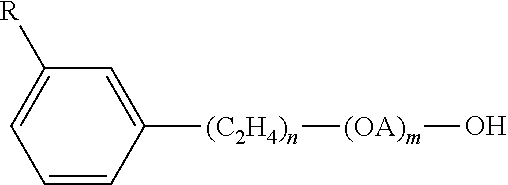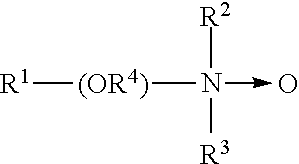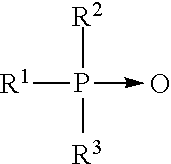Silicone lubricant with good wetting on pet surfaces
a technology of silicone lubricant and pet surface, which is applied in the field of conveyor lubricants, can solve the problems of bottle failure either by leakage or bursting, environmental stress cracking, and amorphous polymers are more susceptible to stress cracking
- Summary
- Abstract
- Description
- Claims
- Application Information
AI Technical Summary
Benefits of technology
Problems solved by technology
Method used
Image
Examples
examples
[0108]The invention can be better understood by reviewing the following examples. The examples are for illustration purposes only, and do not limit the scope of the invention.
example 1
Silicone Lubricant Plus Alcohol Ethoxylate Wetting Agent
[0111]A lubricant composition was prepared by adding 8.0 g of a 10% aqueous solution of Surfonic L 24-7 surfactant (available from Huntsman Chemical, Houston Tex.) to 992 g of the silicone lubricant composition of Comparative Example B. The lubricant composition contained 248 ppm Lambent E2140FG silicone emulsion, 800 ppm of Surfonic L 24-7, and 333 ppm sodium bicarbonate (equivalent to 200 ppm alkalinity as CaCO3). The contact angle of the lubricant composition on PET film was determined to be 24 degrees, and the surface tension of the composition was 28.3 dynes / cm. The wetting behavior of the lubricant composition was evaluated by the coating test described above. Upon coating, the composition gave a uniform film with approximately 10 pin head size spots where the liquid had partially de wet the surface. When dried, the coating was slightly hazy, with about 16 spots about 1 cm in diameter where the composition had partially d...
example 2
Silicone Lubricant Plus Silicone Wetting Agent
[0112]A lubricant composition was prepared by adding 5.2 g of a 10% aqueous solution of Silwet L-77 surfactant (available from GE Silicones, Friendly, W. Va.) to 1000 g of the silicone lubricant composition of Comparative Example B. The lubricant composition contained 249 ppm Lambent E2140FG silicone emulsion, 517 ppm of Silwet L-77, and 334 ppm sodium bicarbonate (equivalent to 200 ppm alkalinity as CaCO3). The contact angle of the lubricant composition on PET film was determined to be 49 degrees. The surface tension of the composition was 23.6 dynes / cm. The wetting behavior of the lubricant composition was evaluated by the coating test described above. Upon coating, the composition gave a film with approximately 100 spots of about 0.5 cm diameter where the liquid had de wet the surface. When dried, the coating was hazy, with about 100 de wet spots about 0.7 cm in diameter. Around each defect was a diffuse hazy halo. The dried coating c...
PUM
| Property | Measurement | Unit |
|---|---|---|
| coating thickness | aaaaa | aaaaa |
| contact angle | aaaaa | aaaaa |
| diameter | aaaaa | aaaaa |
Abstract
Description
Claims
Application Information
 Login to View More
Login to View More - R&D
- Intellectual Property
- Life Sciences
- Materials
- Tech Scout
- Unparalleled Data Quality
- Higher Quality Content
- 60% Fewer Hallucinations
Browse by: Latest US Patents, China's latest patents, Technical Efficacy Thesaurus, Application Domain, Technology Topic, Popular Technical Reports.
© 2025 PatSnap. All rights reserved.Legal|Privacy policy|Modern Slavery Act Transparency Statement|Sitemap|About US| Contact US: help@patsnap.com



